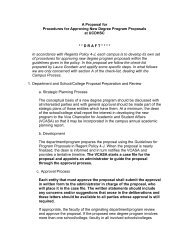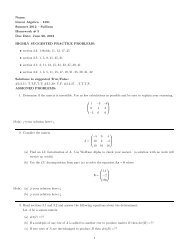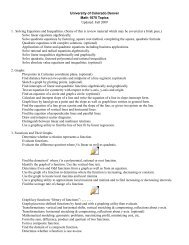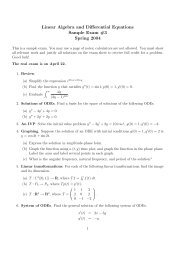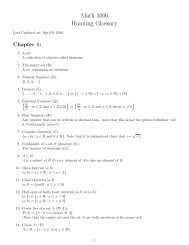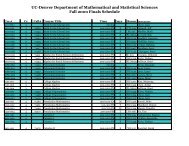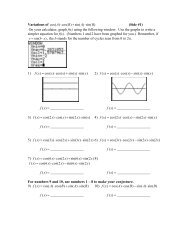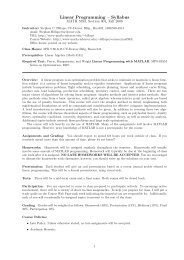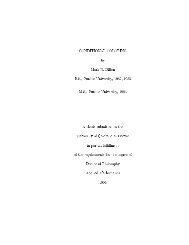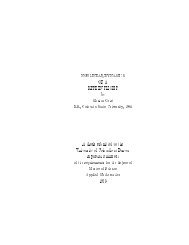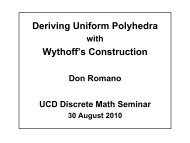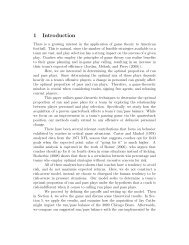Fourier, Jean Baptiste Joseph - Mathematical & Statistical Sciences
Fourier, Jean Baptiste Joseph - Mathematical & Statistical Sciences
Fourier, Jean Baptiste Joseph - Mathematical & Statistical Sciences
You also want an ePaper? Increase the reach of your titles
YUMPU automatically turns print PDFs into web optimized ePapers that Google loves.
<strong>Fourier</strong>, <strong>Jean</strong> <strong>Baptiste</strong> <strong>Joseph</strong><br />
Shaun Rezaiefard<br />
MATH 4010<br />
The French mathematical physicist <strong>Jean</strong> <strong>Baptiste</strong> <strong>Joseph</strong> <strong>Fourier</strong> (1768-1830) was<br />
the first to discuss, in a comprehensive manner, the various aspects of the flow of heat in<br />
bodies. His accomplishments in the mathematical and physical world have left an<br />
immeasurable impact on our own civilization and his methods are indispensable today.<br />
<strong>Jean</strong> <strong>Baptiste</strong> <strong>Joseph</strong> <strong>Fourier</strong> was born southeast of Paris in Auxerre, France on<br />
March 21, 1768. <strong>Jean</strong> <strong>Baptiste</strong> was the son of a tailor, <strong>Joseph</strong> <strong>Fourier</strong>, whose wife was<br />
Edmée <strong>Fourier</strong>. By the age of 8, <strong>Joseph</strong>’s father had died, and less than a year after this<br />
tragedy his mother had passed away, leaving <strong>Joseph</strong> <strong>Fourier</strong> an orphan by the age of 8 1 .<br />
Shortly after, a charitable lady who had been captivated by the boy’s good manners and<br />
serious deportment recommended him to the Bishop of Auxerre. The Bishop got <strong>Fourier</strong><br />
into the local military college run by Benedictine Monks, where the boy soon proved his<br />
genius. By the age of twelve <strong>Fourier</strong> was writing magnificent sermons for the leading<br />
church dignitaries of Paris to palm off as their own. At thirteen he was a problem child,<br />
disobedient, ill-tempered, and full of the devil generally. Then, at his first encounter with<br />
mathematics, he changed as if he had been reborn by magic. He figured out what had<br />
been making him such a problem child and cured himself of it. 5 <strong>Fourier</strong> became so<br />
obsessed with mathematics that after his bedtime he would collect candle-ends from the<br />
kitchen and anywhere else he could find them in the college to provide light for his<br />
mathematical studies. 5 He had a secret study in a nook by a large fireplace behind a<br />
screen.
Shaun Rezaiefard<br />
MATH 4010<br />
While staying at the local military school <strong>Fourier</strong> wanted to join either the<br />
artillery or the engineers, which were branches of the military then generally available to<br />
all classes of society; but <strong>Fourier</strong> was turned down for some reason. 12 The good<br />
Benedictine monks prevailed upon the young genius to choose the priesthood as his<br />
profession, and he entered the abbey of St. Benoit-sur-Loire to become a novitiate. He<br />
had always wanted to be a solider and had chosen the priesthood only because<br />
commissions were not given to sons of tailors. 9 The French Revolution interfered with<br />
these plans and set him free. 5 His old friends at Auxerre knew all a long that <strong>Fourier</strong><br />
would never make a monk so they took him back in 1789 and made him a professor of<br />
mathematics at his old school. This was the first step (indeed a long one) toward his<br />
ambition. <strong>Fourier</strong> proved his versatility by teaching his colleagues’ classes when they<br />
were ill, usually better than they did themselves, in everything from physics to the<br />
classics.<br />
In December 1789, <strong>Fourier</strong> (21 years of age) went to Paris to present his<br />
researches on the solution of numerical equations before the Academy. 5 This work was<br />
beyond Lagrange and is still of value. <strong>Fourier</strong>’s first memoir on the numerical solution of<br />
algebraic equations was read before the French Academy of <strong>Sciences</strong>. The subject<br />
became one of his life-long interests. 5<br />
<strong>Fourier</strong>, of course, lived during the French Revolution and was an enthusiast for<br />
the Revolution from the start. 6 Then the Revolution got out of hand and <strong>Fourier</strong><br />
protested against the needless brutality. 6 He was prominent in local affairs and his<br />
courageous defense of the victims of the Terror led to his arrest in 1794. He personally<br />
appealed to Robespierre, who led the Reign of Terror, which turned out to be
Shaun Rezaiefard<br />
MATH 4010<br />
unsuccessful. <strong>Fourier</strong> was later released when Robespierre was executed on July 28,<br />
1794.<br />
It is to Napoleon’s everlasting credit that he was one of the first to see with cold-<br />
blooded clarity that ignorance of itself can do nothing but destroy. 5 His own work may<br />
not have been much better in the end, but he did recognize that such a thing as<br />
civilization might be possible. Then Napoleon ordered and encouraged the creation of<br />
schools. The problem that arose was the lack of teachers at that time. The École<br />
Normale was created in 1794 because it was imperative to train new teaching<br />
corporations of over fifteen hundred. <strong>Fourier</strong> was called to the chair of mathematics as a<br />
reward for his recruiting in Auxerre. With his new appointment began a new era in<br />
teaching French mathematics. <strong>Fourier</strong> remembered the deadly lectures of redundant<br />
professors who memorized and delivered the same lectures year after year, the<br />
Convention called in creators of mathematics to do the teachings. He forbade them to<br />
lecture from any notes at all. The lectures were to be given standing and not sitting half<br />
asleep behind a desk. The professors and the class were free to interchange questions and<br />
explanations, but it was up to the professor to prevent lecture from turning into a<br />
pointless debate. The École Normale was opened and closed within a year and in that<br />
case <strong>Fourier</strong> only spent a short time there but nevertheless he made a strong impression.<br />
The success of his scheme surpassed expectations and led to one of the most brilliant<br />
periods in the history of French mathematics and science.<br />
Shortly after in 1795 the École Polytechnique started and he was appointed<br />
administrateur de police, or assistant lecturer, to support the teaching of Lagrange and<br />
Monge then later as a professor of mathematical analysis. At Polytechnique he enlivened
Shaun Rezaiefard<br />
MATH 4010<br />
his lectures on mathematics by out-of-the-way historical allusions (many of which he was<br />
the first to trace to their sources), and he skillfully tempered abstractions with interesting<br />
applications. 5 There, at Polytechnique, <strong>Fourier</strong> became victim of the reaction to the<br />
previous regime and was, ironically, arrested as a supporter of Robespierre. Robespierre<br />
had declined his earlier appeal when <strong>Fourier</strong> was first arrested. His colleagues at École<br />
successfully sought his release. 12<br />
In 1798, Monge selected <strong>Fourier</strong> to join Napoleon’s Egyptian campaign as one of<br />
the Legion of Culture to civilize Egypt—“to offer a succoring hand to unhappy peoples,<br />
to free them from the brutalizing yoke under which they have groaned for centuries, and<br />
finally to endow them without delay with all the benefits of European civilization.”<br />
<strong>Fourier</strong> became a secretary of the newly formed Institute d’Egypte, where he became<br />
Napoleon’s right hand man who conducted negotiations between Napoleon and Sitty-<br />
Neficah (the wife of the chief bey, Murad). <strong>Fourier</strong> also held other diplomatic posts as<br />
well as pursuing research in Egypt. 5 He was 30 when Napoleon requested his<br />
participation as scientific adviser on an expedition to Egypt. From 1798 to 1802 <strong>Fourier</strong><br />
served as secretary of the Institut d’Egypte, which was established by Napoleon to<br />
explore the archeological riches of that ancient land. In his papers published in the<br />
Decade and the Courrier d’Egypte it showed him to be preoccupied with problems that<br />
ranged from the general solutions of algebraic equations to irrigation projects.<br />
On January 2, 1802 <strong>Fourier</strong> had finally retuned to France and was appointed<br />
prefect of the Department of Isere, with headquarters at Grenoble. 13 Grenoble extended<br />
to what was then the Italian border. His first task was to restore order there because it<br />
was in political turmoil. The citizens of Grenoble were much upset by the religious
Shaun Rezaiefard<br />
MATH 4010<br />
implications of some of the Institute d’Egpyte’s discoveries, particularly the great age<br />
assigned to the older monuments, which conflicted with the chronology of the Bible.<br />
They calmed down when <strong>Fourier</strong> dug up a saint in his own family, the blessed Pierre<br />
<strong>Fourier</strong>, his great-uncle, whose memory was hallowed because he had founded a religious<br />
order. The archeological researches nearer home to the Grenoble citizens made them<br />
quite satisfied with <strong>Fourier</strong>. Now with his respectability regained, <strong>Fourier</strong> accomplished<br />
a vast amount of useful work such as reconciliation of thirty-seven different communities<br />
to the drainage of a huge area of marshland near Bourgoin into valuable land, stamping<br />
out malaria, planning and partial construction of a road from Grenoble to Turin, and<br />
overall lifting his district out of the Middle ages. 5<br />
While at the Department of Isere, he wrote the work on the mathematical theory<br />
of heat conduction which had earned him lasting fame. His first draft was submitted to<br />
the academy in 1807 and a second more detailed version was sent which received an<br />
award from the academy. 8 His paper was entitled Theorie des mouvements de la chleur<br />
dans les corps solides. The first part of his work was printed in book form in 1822 under<br />
the title Theorie analytique de la Chaluer (The <strong>Mathematical</strong> Theory of Heat). 8 His<br />
work became a masterpiece because it covered the hitherto unexplored field of heat<br />
propagation but also because it contained the mathematical techniques which later were<br />
developed into a special branch of mathematics—<strong>Fourier</strong> analysis and <strong>Fourier</strong> integrals.<br />
The Academy encouraged <strong>Fourier</strong> to continue by setting a contribution to the<br />
mathematical theory of heat as its problem for the Grand Prize in 1812. <strong>Fourier</strong> won the<br />
prize, but not without some criticism which he resented deeply but which was well taken.
Shaun Rezaiefard<br />
MATH 4010<br />
Laplace, Lagrange, and Legendre were the referees. While admitting the novelty<br />
and importance of <strong>Fourier</strong>’s work they pointed out that the mathematical treatment was<br />
faulty. <strong>Fourier</strong> analysis is the decomposition of a function in the terms of a sum of<br />
sinusoidal functions of different frequencies that can be recombined to obtain the original<br />
function. 14 The <strong>Fourier</strong> series is a type of <strong>Fourier</strong> analysis, which decomposes a periodic<br />
function into a sum of simple functions that may contain sines, cosines or complex<br />
exponentials 4 .<br />
Imagine we have a block of metal and the surface is maintained at a fixed<br />
temperature. Then under physical considerations the interior temperature distributions at<br />
initial time, t=0, is all you need to find the interior distributions at all future times. 7 Even<br />
if the initial temperature distribution changes <strong>Fourier</strong> asserted that “nevertheless it is<br />
equal to the sum of a series of sines and cosines” 4 . Here <strong>Fourier</strong> was repeating Bernoulli<br />
except for the fact that Bernoulli was only speaking of functions that are formed by a<br />
single expression and <strong>Fourier</strong> included those functions given piecewise by several<br />
different formulas 3 . <strong>Fourier</strong> was asserting that the distinction of function and graph was<br />
nonexistent. Since every function represents a graph, then every graph represents a<br />
function, called its <strong>Fourier</strong> series 2 . Lagrange, one of the creators of variational calculus,<br />
and many other great mathematicians found <strong>Fourier</strong>’s claim very hard to believe 1 .<br />
<strong>Fourier</strong>’s most important step was finding the formula of the coefficients in the<br />
expansion. Without knowing that Euler and Bernoulli had calculated this previously<br />
<strong>Fourier</strong> calculated it all over again. All three of the mathematicians looked past the direct<br />
method of orthogonality, which could have solved the problem in just one line of work 4 .
Shaun Rezaiefard<br />
MATH 4010<br />
<strong>Fourier</strong> went through an incredible computation, which has been called a classic example<br />
of physical insight leading to the right answer in spite of flagrantly wrong reasoning 2 .<br />
<strong>Fourier</strong> started out expanding each sine function in a power series and then<br />
rearranged the terms so that the arbitrary function f was represented by a power series.<br />
This was the first sign of wrong reasoning by <strong>Fourier</strong> because the functions he had in<br />
mind have no such expansion in general. This did not stop <strong>Fourier</strong> as he proceeded to<br />
find the coefficients of this nonexistent power-series expansion. Using his inconsistent<br />
assumptions he arrived at answer where he used division by an arbitrarily large number.<br />
This formula concluded that the arbitrary function is zero because all the coefficients<br />
vanish. Unhappy with the results <strong>Fourier</strong> manipulated his solution to arrive at the same<br />
simple formula Euler had concluded over thirty years prior 2 .<br />
After the vigorous calculations <strong>Fourier</strong> accomplished to arrive at Euler’s formula,<br />
he realized that he could have used the direct method of orthogonality to compute the<br />
problem in one line, just as Euler did 2 . <strong>Fourier</strong> was the first to observe that the final<br />
coefficient formula remained meaningful for any graph bounded by a definite area. He<br />
then concluded that this worked for any and all graphs. With his previous computations<br />
of the <strong>Fourier</strong> series for a number of special examples, he soon found that numerically in<br />
every case that the sum of the first few terms was very close to the actual graph that<br />
generated the series. With this in mind, he claimed that every graph, no matter how<br />
many pieces it consists of, is representable by a series of sines and cosines 2 . <strong>Fourier</strong> was<br />
correct, but he never stated or proved a correct theorem of the <strong>Fourier</strong> series. It took<br />
nearly a century of work by mathematicians to make sense of what <strong>Fourier</strong> did to<br />
accomplish the <strong>Fourier</strong> series.
Shaun Rezaiefard<br />
MATH 4010<br />
Fully aware that he had done something of the first magnitude <strong>Fourier</strong> paid no<br />
attention to his critics. They were right, he was wrong, but he had done enough in his<br />
own way to entitle him to independence. <strong>Fourier</strong>’s resentment was rationalized in attacks<br />
on pure mathematicians was rationalized in attacks on pure mathematicians for minding<br />
their own proper business and not blundering about in mathematical physics. 11<br />
On March 1, 1815, Napoleon had escaped from Elba and landed on the French<br />
coast. All was going well for <strong>Fourier</strong> and France in general. 13 <strong>Fourier</strong> started to fear that<br />
the populace would welcome Napoleon back for another spree, <strong>Fourier</strong> hurried to Lyons<br />
to tell the Bourbons what was about to happen. 14 They refused to believe him and<br />
<strong>Fourier</strong> was taken prisoner and brought before Napoleon at Bourgoin. There he was<br />
confronted by Napoleon who was bending over a map, a pair of compasses in his hand<br />
and said:<br />
“Well, Monsieur Prefect! You too; you have declared war against me?” 5<br />
“Sire,” <strong>Fourier</strong> stammered, “my oaths made it a duty.” 5<br />
“A duty, do you say? Don’t you see that nobody in the country is of your opinion? And<br />
don’t let yourself imagine that your plan of campaign frightens me much. I suffer only at<br />
seeing amongst my adversaries an Egyptian, a man who has eaten the bread of the<br />
bivouac with me, an old friend! How, moreover, Monsieur <strong>Fourier</strong>, have you been able<br />
to forget that I made you what you are?” 5<br />
A few days later Napoleon had asked the now loyal <strong>Fourier</strong>:<br />
“What do you think of my plan?” 5<br />
“Sire, I believe you will fail. You will meet a fanatic on your road, and everything will<br />
be over.” 5
Shaun Rezaiefard<br />
MATH 4010<br />
“Bah! Nobody is for the Bourbons—not even a fanatic. As for that, you have read in the<br />
papers that they have put me outside the law. I myself will be more indulgent: I shall<br />
content myself with putting them outside the Tuileries!” 5<br />
Before the end of Napoleon’s Hundred Days, <strong>Fourier</strong> had resigned his new title<br />
and prefecture in protest against the severity of the regime and had come to Paris to try to<br />
take up research full time, which had previously been part-time activity.<br />
This was the low point of <strong>Fourier</strong>’s life. He had no job, only a small pension, and<br />
low political reputation. But before he could starve to death a former student at the Ecole<br />
Polytechnique and companion in Egypt, Chabrol de Volvic, was now prefect of the<br />
department of the Seine and appointed him director of its Bureau of Statistics, which was<br />
a position without heavy duties but came with a salary good enough for his needs. 11<br />
In 1816 <strong>Fourier</strong> was elected to the reconstituted Academie des <strong>Sciences</strong>, but<br />
Louis XVIII could not forgive him for having accepted the prefecture of the Rhone from<br />
Napoleon, and was refused. Later some diplomatic negotiation eventually cleared up the<br />
situation and he was elected in 1817. In 1822, he was elected to the powerful position<br />
secretaire perpetual of the Academic des <strong>Sciences</strong>, and in 1827 was elected to the<br />
Academie Francaise. He was also elected a foreign member of the Royal Society.<br />
<strong>Fourier</strong>’s obsession with heat and his mathematical theory of heat conduction<br />
were responsible for hastening his death. <strong>Fourier</strong> loved to sweat so much that he would<br />
go into saunas in layers of clothes. 13 His experiences in Egypt led him to believe that the<br />
desert heat was the ideal condition for health. His friends stated that <strong>Fourier</strong> lived in<br />
rooms that were hotter than hell and the Sahara desert combined! On May 16, 1830<br />
<strong>Fourier</strong> died of heart disease (some say an aneurism). He was sixty-three years old when
Shaun Rezaiefard<br />
MATH 4010<br />
he passed. During the course of his career <strong>Fourier</strong> wrote several papers on statistics, but<br />
his lifelong love was the theory of algebraic equations on which he had just completed<br />
the manuscript of a book, Analyse des equations determinees, and a lengthy memoir<br />
when he died. <strong>Fourier</strong> was buried in the eighteenth division of the cemetery of Pere<br />
Lachaise. He belongs to a select group of mathematicians whose work is so fundamental<br />
that their names have become adjectives in every civilized language.
1 “<strong>Fourier</strong>, <strong>Jean</strong> <strong>Baptiste</strong> <strong>Joseph</strong>.” Complete Dictionary of Scientific Biography. Vol.5. Detroit: Charles Scriber’s Sons,<br />
2007, 93-99.<br />
2 Davis J., Philip, and Hersh, Reuben, The <strong>Mathematical</strong> Experience, New York: Mariner Books/ Houghton Mifflin<br />
Company, 1999, 261-265.<br />
3 “Baron <strong>Jean</strong> <strong>Baptiste</strong> <strong>Joseph</strong> <strong>Fourier</strong>.” Encyclopedia of World Biography. Vol.6. 2 nd ed. Detroit: Gale, 2004. 32-33.<br />
4 <strong>Joseph</strong> <strong>Fourier</strong>, translated by Alexander Freeman (published 1822, translated 1878, re-released 2003). The Analytical<br />
Theory of Heat. Dover Publications.2003 unabridged republication of the 1878 English translation by Alexander Freeman of<br />
<strong>Fourier</strong>'s work Théorie Analytique de la Chaleur, originally published in 1822.<br />
5 Bell, Eric Temple, Men of Mathematics, New York: Touchstone Books/Simon & Schuster 1986. 183-205.<br />
6 Newton, Isaac, 1701, "A Scale of the degrees of Heat", Phil Trans Royal Soc (London), 22, p.824<br />
7 Adiutori, E. F., 1990, "Origins of the Heat Transfer Coefficient", Mechanical Engineering, August, pp 46-50<br />
8 <strong>Fourier</strong>, <strong>Joseph</strong>, 1822, The Analytical Theory of Heat, English translation by Freeman (1878); republication by Dover, New<br />
York (1955)<br />
9 Grattan-Guinness, I., 1972, <strong>Joseph</strong> <strong>Fourier</strong> 1768-1830, The MIT Press, Cambridge, p. viii to ix,<br />
10 Herivel, J., 1975, <strong>Joseph</strong> <strong>Fourier</strong>, Clarendon Press, Oxford<br />
11 Biot, J.B., 1804, "Memoire sur la propagation de la chaleur", Bibliotheque Brittanique 37, 310-329, per Herivel (1975).<br />
See also reprint in Int J Heat Mass Transfer, V 13, pp 1069-1099, Pergamon Press, 1970<br />
12 Lienhard, J. H., 1983, "Notes on the Origins and Evolution of the Subject of Heat Transfer", Mechanical Engineering,<br />
June, pp 20-27<br />
13 Maxwell, J.C, 1873, Electricity and Magnetism, v1, pp 296, 297 per Krause reprint of 1891 translation of Ohm (1827)<br />
14 Galileo, 1638, Two New <strong>Sciences</strong>, translated by Henry Crew and Alfonso de Salvio, Encyclopaedia Britannica, Inc., 1952



